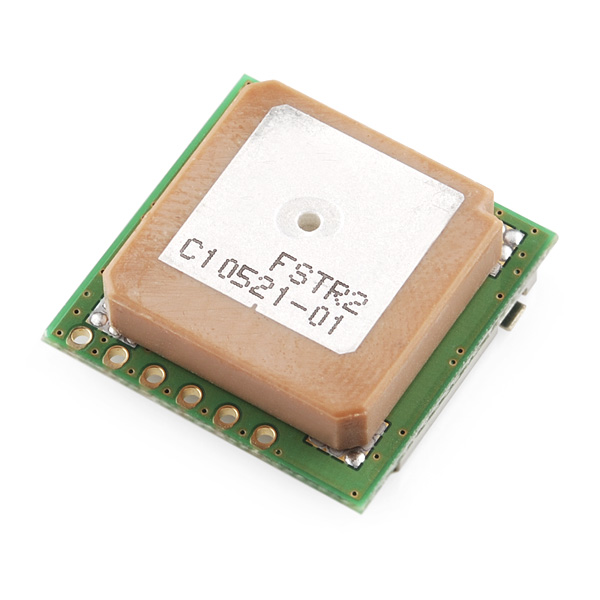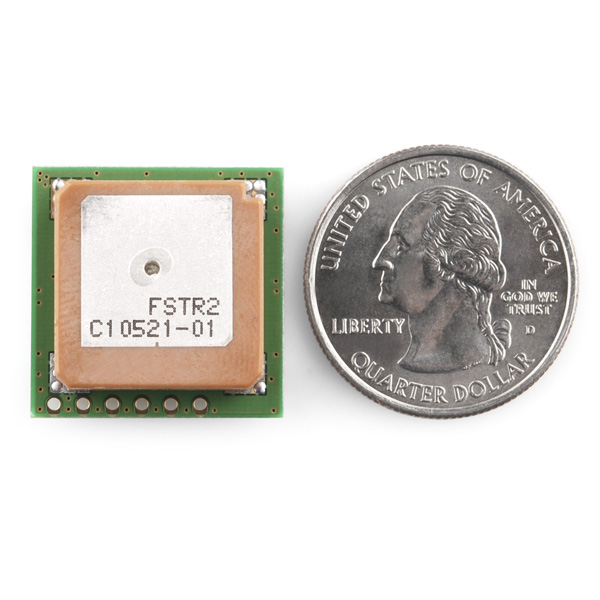66 Channel UP-501 GPS Receiver
Replacement: None. There is no direct replacement for this particular GPS module. This page is for reference only.
This Fastrax UP501 is an awesome little module for navigation, package tracking and any other application where simple, reliable positioning data is a necessity. To get it up and running, all you have to do is hook up a 3 - 4.2V power supply and a serial data line. The UP501 also supports dedicated control commands for external control. The built-in PCB-mounting flanges and standard 2.54mm IO-pin pitch make it easy to mount in your project. What are you waiting for? Go navigate something!
Not sure which GPS module is right for you? Check out our GPS buying guide!
- 66 channels
- Supply Voltage 3.0 - 4.2VDC
- Low power consumption: 75mW @ 3.0V
- Configurable fix rate, up to 10Hz
- Ultra High Sensitivity:
- –148dBm (Cold Start Acquisition)
- –165 dBm (Navigation)
- Tiny form factor – 22mm x 22mm x 8mm
- Embedded patch antenna 18.4 x 18.4 x 4.2 mm
- NMEA protocols (default speed: 9600bps)
- One serial port (CMOS level)
- 1PPS output
- WAAS/EGNOS support
- MediaTek MT3329, 66-channel receiver
- 22.0 x 22.0mm x 8mm
- Datasheet
- [NMEA Manual](http://cdn.sparkfun.com/datasheets/Sensors/GPS/NMEA manual for Fastrax IT500 Series GPS receivers_V1.7.pdf)
- [GPS Viewer Software](http://cdn.sparkfun.com/datasheets/Sensors/GPS/GPS Viewer_101116.zip)
Comments
Looking for answers to technical questions?
We welcome your comments and suggestions below. However, if you are looking for solutions to technical questions please see our Technical Assistance page.
Customer Reviews
No reviews yet.





You should revise the "One serial port" bullet item to indicate this module just does CMOS level serial. According to the data sheet, you can get RS232 voltages by selecting a different module "UP500R". The way it is worded here makes it sound like it is user-selectable on this module.
good call, fixed.
Anyone know where I can get an EAGLE lbr file for this? EDIT: Nevermind, I don't think sometimes.
lol, I really feel so stupid to ask you where you found it? Because I can't :(
The description says this uses the MediaTek MT3318 chipset, but i'm not sure that's correct. On FastTrax's website, the UP501 brochure that says the chipset is the MT3329. The specs here match the MT3329 and not the 3318 (eg, 10Hz update rate vs 5Hz, -148/-165 dBm cold start/navigation vs -146/-158 dBm, 66 channels vs 51...)
We are working on getting this updated. Thanks for pointing that out!
I have difficulty understanding the 66 channel part. There aren't 66 (GPS)satellites, and the receiver can only see those satellites above the horizon, and not around the curvature of the Earth. I doubt that it is intended for space use since it isn't RH (radiation hardened). Just a marketing ploy?
Having 66 channels makes for a faster start-up. From a cold start, the receiver has to look at every frequency where a satellite could be at until it finds the right ones. (Frequencies change due to doppler as the satellites whiz along overhead.)
Once you have the right frequency, you can look at different bit phases (although I don't know if they use different channels for that).
If you have 66 channels, you can look at 66 frequencies/phases at once, giving faster start-up.
Fastrax UP501 GPS receiver not working with Fez Panda2 board
I am using Fastrax UP501 GPS receiver module which is connected to the Fez Panda II board over the UART. I am sending the GPS commands from the microcontroller based board to GPS receiver using serial communication but there is no response from the GPS for the sent command. This same board uses some other UART modules and it works fine with same kind of serial communication. I tried to send following test command
$PMTK000*32\r\n
and was expecting following acknowledge string
$PMTK001,000,3*32\r\n
But this GPS module do not show any data which is received on microcontroller board through that serial communication. Can anyone help to resolve this issue. Is there anything I am missing in sending the command.
Make sure you have the VDD-B hooked up. It won't work without it.
I contacted the manufacturer to see if this would work for a high altitude balloon and it appears that it will not. According to their tech support the UP501 uses OR logic to perform the cutoff. If the GPS exceeds either the 60000ft altitude or the 1000knot speed limit, it will shutdown.
Just a suggestion, but where it says "Tiny form factor - 22mm x 22mm x 8mm", I would use a colon instead of a dash, I read it as negative 22 mm for a second.
a -22 wouldn't really make sense though
Anyone able to change settings on this? I can get data from it with the default settings, but can't seem to change anything using the Fastrax GPS Workbench software. I'd like to change the baud rate and update rate.
Edit: Never mind. Breadboard error. Works fine once you connect it correctly. :)
Jamie (or anybody) - The datasheet mentions it defaults to NMEA output (and i'm assuming output is enabled so it defaults to actually spitting out the NMEA data). The datasheet doesn't mention if PPS is output by default. Can anybody confirm for me that default has the PPS pin doing its thing? Thanks much.
Any idea if this will work above 60,000 feet?
I'm working on a custom HSIS inspired board and this isn't a candidate if it has an altitude lock.
Oh, cool, dude! Now I'm working on High Altitude Balloon Project(current status: programming and assembling)and after launch I'm going work on very-very small (nano? femto!) sputnik. Of course, you and i are solving the same problems.
If you are interested in, pls, contact me yonas.shvabas_at_gmail_com. I don't really know what does for you HSIS mean.